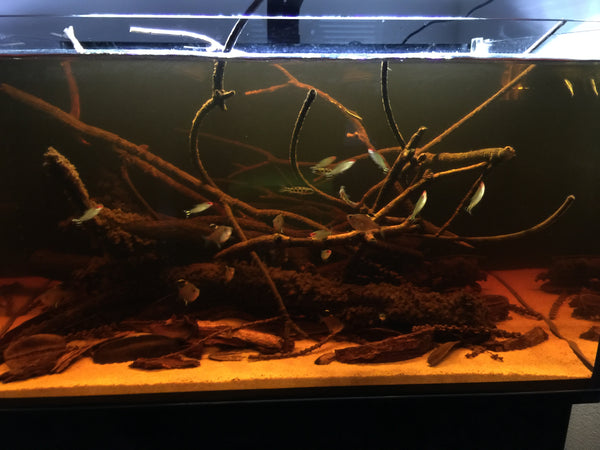- Continue Shopping
- Your Cart is Empty
Exceeding expectations? Or just matching them?
Several months in to my latest botanical-style brackish aquarium, and I'm finding that this tank is absolutely exceeding my expectations in every way.
Sort of.
I mean, I kind of expected it to work the way it has...
I have for several years played with this brackish concept, but I am thinking that I'm now In a better place than I was previously.
Why?
Well, I think the "marriage" of the blackwater, botanical-style aquarium "best practices" and theories I've had about how to configure and manage this type of aquarium has intersected nicely with the idea of a richer, more "wholistic" brackish aquatic environment.
In other words, my ideas are kind of working!
And, without sounding arrogant or anything, this really isn't that surprising. The idea of an aquarium-freshwater or brackish- enhanced by an influx of decomposing leaves and botanical materials, as well as their associated microbial diversity, and a tint to the water imparted by the tannins from them makes a lot of sense.
It works, so it would stand to reason that it would work with a brackish water environment.
In fact, as we've sort of proffered for a while, many of the more interesting brackish water habitats that we attempt to replicate are muddy, darkly-tinted, highly biologically diverse systems- not the "white/grey", brightly-illuminated, clear water, aragonite-sand-and-rock aquascapes that the hobby has traditionally associated with this style of aquarium.
This is not a "victory lap" or anything like that. What I intend to do by discussing this today in "The Tint" is to encourage you to "cross-pollinate" your aquarium practice by incorporating ideas from different styles of aquariums and melding them whenever possible.
Ideas like creating a tank which supports biological diversity, accepting decomposition and halophytes (salt-loving plants) working together to further enhance and take advantage of this unique environmental niche.
I would like to think that this brackish tank represents more than just a cool-looking aquascape. Rather, I hope it's a sot of "signpost" on the highway of aquarium practice...
A call to merge what we know with things we likely haven't tried before.
A call to embrace incorporating combinations of techniques and ideas in ways not previously widely accepted.
We've seen this before, huh?
What's next?
A lot of interesting things, as we collectively continue to evolve our hobby and push the boundaries back from what has been considered the "de facto" ways to do stuff...
I'd like to see us expand the use of botanicals into the marine/reef sector as well. In other words, utilizing mud, mangroves leaves and other botanicals to replicate more diverse and unique marine environments, such as the interface between estuaries and reefs- highly unusual "hybrid" habitats with a remarkable biodiversity, and opportunities to create more realistic aquarium simulations of these seldom-replicated habitats.

So many possibilities to work with...so much inspiration from nature to put into play in ways not previously executed.
And it all starts with ideas, a little bit of initiative, and some courage.
Stay excited. Stay inspired. Stay motivated. Stay creative...
And Stay Wet.
Scott Fellman
Tannin Aquatics















Scott Fellman
Author